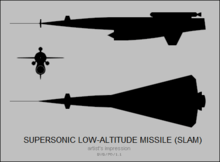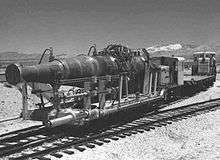Supersonic Low Altitude Missile

The Supersonic Low Altitude Missile or SLAM was a U.S. Air Force nuclear weapons project conceived around 1955, and cancelled in 1964. SLAMs were conceived of as unmanned nuclear-powered ramjets capable of delivering thermonuclear warheads deep into enemy territory. The development of ICBMs in the 1950s rendered the concept of SLAMs obsolete. Advances in defensive ground radar also made the stratagem of low-altitude evasion ineffective. Although it never proceeded beyond the initial design and testing phase before being declared obsolete, the design contained several radical innovations as a nuclear delivery system.
Conceived role


The SLAM was designed to complement the doctrine of mutually assured destruction, and as a possible replacement for, or augment to, the Strategic Air Command system. In the event of nuclear war it was intended to fly below the cover of enemy radar at supersonic speeds, and deliver thermonuclear warheads to roughly 16 targets.
Innovations
The use of a nuclear engine in the airframe promised to give the missile staggering and unprecedented low-altitude range, estimated to be roughly 113,000 miles (182,000 km) (over four and a half times the equatorial circumference of the earth). The engine also acted as a secondary weapon for the missile: direct neutron radiation from the virtually unshielded reactor would sicken, injure, or kill living things beneath the flight path; the stream of fallout left in its wake would poison enemy territory; and its strategically selected crash site would receive intense radioactive contamination. In addition, the sonic waves given off by its passage would damage ground installations.
Another revolutionary aspect of the SLAM was its reliance on automation. It would have the mission of a long-range bomber, but would be completely unmanned: accepting radioed commands up to its failsafe point, whereafter it would rely on a terrain contour matching (TERCOM) radar system to navigate to preprogrammed targets.
Development
The primary innovation was the engine of the aircraft, which was developed under the aegis of a separate project code-named Project Pluto, after the Roman god of the underworld. It was a ramjet that used nuclear fission to superheat incoming air instead of chemical fuel. Project Pluto produced two working prototypes of this engine, the Tory-IIA and the Tory-IIC, which were successfully tested in the Nevada desert. Special ceramics had to be developed to meet the stringent weight and tremendous heat tolerances demanded of the SLAM's reactor. These were developed by the Coors Porcelain Company. The reactor itself was designed at the Lawrence Radiation Laboratory.
Although a prototype of the airframe was never constructed, the SLAM was to be a wingless, fin-guided aircraft. Apart from the ventral ram-air intake it was very much in keeping with traditional missile design. Its estimated airspeed at thirty thousand feet was Mach 4.2.
The SLAM program was scrapped on July 1, 1964. By this time serious questions about its viability had been raised, such as how to test a device that would emit copious amounts of radioactive exhaust from its unshielded reactor core in flight, as well as its efficacy and cost. ICBMs promised swifter delivery to targets, and because of their speed (the Thor could reach its target in 18 minutes, whereas the SLAM would take much longer) and trajectory were considered virtually unstoppable. The SLAM was also being outpaced by advances in defensive ground radar, which threatened to render its stratagem of low-altitude evasion ineffective.
Reactor design
The reactor had outer diameter of 57.25 inches (1.454 m) and length 64.24 inches (1.632 m); the dimension of the reactor core was 47.24 inches (1.200 m) diameter and 50.70 inches (1.288 m) length. The critical mass of uranium was 59.90 kg, and the reactor's power density averaged at 10 megawatts/cubic foot, with total power of 600 megawatts.
The nuclear fuel elements were made of refractory ceramic based on beryllium oxide, with enriched uranium dioxide as fuel and small amount of zirconium dioxide for structural stability. The fuel elements were hollow hexagonal tubes about 4 inches (10 cm) long with 0.3 inches (7.6 mm) distance between the outer parallel planes, with inside diameter of 0.227 inches (5.8 mm). They were manufactured by high-pressure extruding of the green compact, then sintering almost to its theoretical density. The core consisted of 465,000 individual elements stacked to form 27,000 airflow channels; the design with small unattached elements reduced problems related with thermal stresses. The elements were designed for average operation temperature of 2,330 °F (1,277 °C); the autoignition point of the reactor base plates was only 150 °C higher. The neutron flux was calculated to be 9×1017 neutrons/cm2·s in the aft and 7×1014 neutrons/cm2·s in the nose. The gamma radiation level was fairly high due to the lack of shielding; radiation hardening for the guidance electronics had to be designed.
The reactors were successfully tested at Jackass Flats of the Nevada Test Site. The Tory II-A reactor, the scaled-down variant, was tested in mid-1961 and successfully ran for several seconds on May 14, 1961. A full-scale variant, the Tory II-C, was run for almost five minutes at full power. The latter test, limited by the air storage facility capacity, ran for 292 seconds. The air fed to the reactor was preheated to 943 °F (506 °C) and compressed to 316 psi, to simulate ramjet flight conditions.[1]
References
- ↑ "SLAM - Radiation". Vought Aircraft Heritage Foundation. Retrieved 10 November 2015.
External links
- The Flying Crowbar from Air And Space Magazine, 1990
- Vought SLAM entry in the Directory of U.S. Military Rockets and Missiles